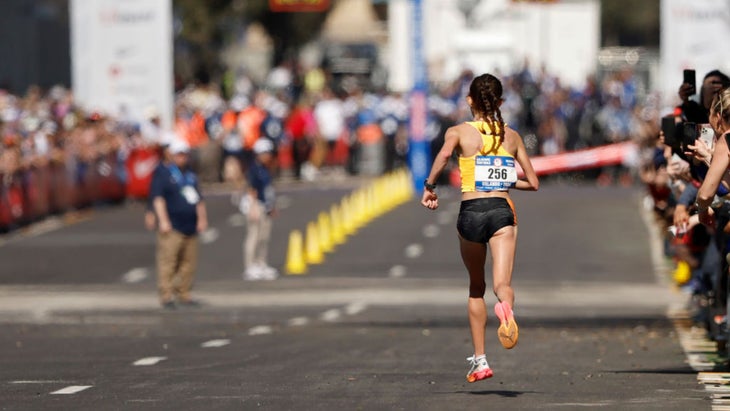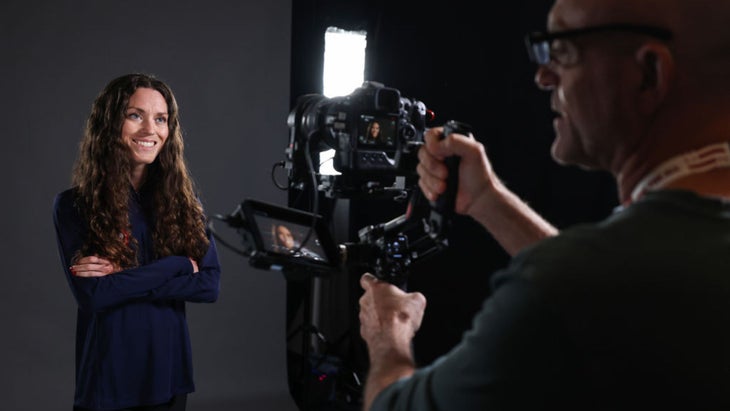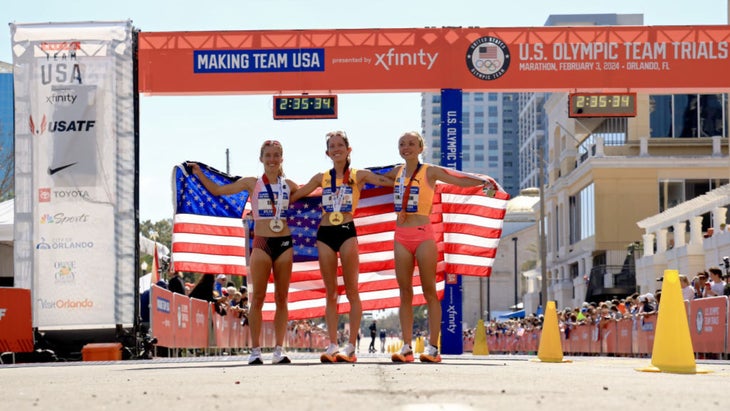New perk: Easily find new routes and hidden gems, upcoming running events, and more near you. Your weekly Local Running Newsletter has everything you need to lace up! Subscribe today.
Fiona O’Keeffe didn’t mind that no one was picking her to make the U.S. Olympic marathon team.
In fact, she liked it—less pressure, no press conferences or pre-race interviews to worry about.
O’Keeffe had an impressive half marathon debut in Houston in 2022, running what was at the time the fastest debut by an American woman in 1:07:42. But the 25-year-old had never run a marathon, and a marathon debutante had never won the U.S. Olympic Trials.
So when she broke away from the lead pack at mile 18 on February 3 in Orlando, Florida, and never looked back en route to winning the race with an event record of 2:22:10, it’s safe to say that she stunned some people.
O’Keeffe’s Puma Elite teammate and close friend Taylor Werner was also surprised, but for the opposite reason. “I thought she was gonna go earlier, if I’m being honest,” Werner says. “I was like, wow, she’s actually listening!”
Or, at least half-listening. Making a move with eight miles to go wasn’t in the race plan drawn up by coaches Alistair and Amy Cragg, who lead the Chapel Hill, North Carolina-based Puma Elite team where O’Keeffe has trained since turning pro in 2021. Making the team, though, absolutely was part of the grand design.
“We felt she had as good of a chance as Betsy Saina, Keira D’Amato, and Emily Sisson,” says Alistair, referring to the three top-seeded women in the race, the latter two being the former and current American record holders in the marathon.
But when he told reporters covering the Trials to keep an eye out for O’Keeffe, their reaction was along the lines of “That’s cute,” he says. “Either people were worried about shiny things, or they weren’t really paying attention. I mean, Fiona is a very scary runner.”
The Craggs felt like they had a secret: not just that O’Keeffe was incredibly fit, but that she could be the next great American marathoner. “I always told her,” says Amy, “You’re gonna do this race, and it’s gonna feel like coming home.”
Meant to Be a Marathoner

O’Keeffe’s road to the marathon began in Davis, California, a small city outside Sacramento, where she was a star performer at Davis High School. There, she earned several state titles and won the 5,000 meters at the 2016 US junior nationals in a record-breaking 15:56:84.
At Stanford University, O’Keeffe became known among her teammates for her quiet confidence and dominance on long runs, which she’d often end up finishing alone, having unintentionally dropped everyone else.
She had a successful but not necessarily a standout college career, becoming an all-American six times and winning several Pac-12 championships. Her penchant for gutsy, aggressive racing was apparent early on.
“From her very first day in college, she was bold,” says Chris Miltenberg, O’Keeffe’s Stanford coach who is now at UNC Chapel Hill. “Not reckless, but bold, fearless, willing to always give herself a shot and put herself in it.”
Also apparent, at least to the Craggs: her destiny as a marathoner. “I was always interested in potential future marathoners,” says Amy [nee Hastings], who won her own U.S. Olympic Trials marathon in 2016, and went on to finish ninth at the Olympics. At one race at Stanford, Alistair pointed her out. “I was like, ‘Oh yeah, she’ll be a good one,’” Amy recalls. “She was willing to hurt, and she wanted to go to the front and go hard from the beginning. There wasn’t any sitting back and waiting.”
But as O’Keeffe’s undergraduate career came to a close, it wasn’t a given that she’d even land a professional contract. She lost her final track season at Stanford to the pandemic, and decided to use her remaining eligibility at the University of New Mexico, where she’d start a graduate program in biology and try to get more races under her belt. “I felt like the extra time for development would be helpful,” she says. “I didn’t know what my options would be—I didn’t have as many performances as would be ideal.”
Her graduate program ended up being online and not quite what she’d hoped for, so after running an Olympic Trials-qualifying time in the 10,000 meters, she began to explore the possibility of a professional contract. She got an agent, who connected her with the Craggs, who were starting their new group in Chapel Hill. O’Keeffe would become just the second athlete on the team.
O’Keeffe’s transition to professional life was rocky. She broke her foot almost immediately, and lived with her coaches for several months as she struggled to find housing. “She just wants to run, and everything else gets in the way of that,” Alistair says. “Finding a house was getting in the way of that.”
She recovered just in time to compete in the 10,000 at the Trials in 2021, which went better than expected with a 20th place finish in 33:03:09 on a very hot day.
At that time, the marathon felt far away, says O’Keeffe, like it was something she’d tackle when she was thirty. But the Craggs were already predicting to anyone who’d listen that they had the next American record holder in the marathon on their team. Once, Amy introduced O’Keeffe to Mary Kate Shea, the elite athlete coordinator at the Boston Marathon, by saying, “This is Fiona. She’s going to win your race one day.” (“I still think she will,” adds Amy today.)
The longer the workouts were getting, the better O’Keeffe was tackling them. When the Craggs sat her down to ask if she’d be interested in working towards a half marathon, she beat them to it—it had already been on her mind.
It’s possible that O’Keeffe’s success at the Houston Half may not have happened had it not been for the windy weather that day. The Craggs decided that the original race plan—to aim for a conservative 70 minutes—would leave O’Keeffe with no one around to protect her from the wind. They told her to tuck into the lead pack, and hoped she could hang on. She could, of course, finishing in fourth and clocking a 10K split (31:54) that was faster than her personal best. (To know O’Keeffe is to realize that a similar result likely would have occurred even if her coaches hadn’t given her the go-ahead to try and run faster.)
Last year, O’Keeffe had hoped to compete in the 10,000 at the USATF Outdoor Track and Field Championships, and to possibly debut in a fall marathon. A severe staph infection in her ankle ended up derailing her schedule and costing her both opportunities. Instead, she ran two more half marathons in the fall, clocking Trials qualifying times in both and punching her ticket to her marathon debut.
Building to the Trials

Debuting at the Trials may not have been the plan in an ideal world. But neither O’Keeffe nor her coaches were particularly phased by the idea.
For one, O’Keeffe was handling marathon workouts “better than anyone I’ve ever known at her age to handle them,” says Amy. She was also soaking in information like a sponge, listening to Amy’s stories about marathons past—including Amy’s own Trials win, which like the 2024 Trials in Orlando, was on a hot day—and learning about the marathon veterans she’d be competing against.
“She was building this massive experience database that you wouldn’t think a debut marathoner at 25 years old would have,” Alistair says.
There was also the lack of pressure and media attention on O’Keeffe, and the advantage of not quite knowing what you’re getting yourself into and therefore not knowing what to be afraid of.
The marathon distance itself wasn’t completely unknown, though. O’Keeffe covered it in training one day when she wasn’t really supposed to—she was running for time, but realized that if she sped up and ran a few extra minutes she could get there, so naturally, she did. In a few dummy builds in 2023, the Craggs had her coming close to the distance every other week, less for her fitness than for her confidence.
She did the brunt of her build in Albuquerque, chosen for having both heat and altitude. Her weekly training volume peaked at around 115 miles per week, including weekly track workouts and some confidence-boosting long runs that had O’Keeffe going between marathon pace (prescribed at 5:30), half marathon pace and fartleks. During those runs, she’d visualize making the team. “I felt like I was actually simulating what I might feel out there,” she says.
Winning the whole race hadn’t really occurred to her, but her coaches and teammates were talking about it behind her back as she crushed workout after workout, always seeming to be totally recovered by the next day. “Fiona was unbreakable,” says Alistair. “We couldn’t see a crack.”
A History-Making Debut

O’Keeffe started tinkering with her race plan—get settled in, tuck into the lead pack, react to moves but don’t make them yourself—relatively early.
Blame the bottles: because of her low seeding in the race, her bottles were placed way after those of the other top athletes in the field, and in an effort to grab them without getting into trouble, O’Keeffe positioned herself towards the front of the pack, her early miles looking more aggressive than she intended them to be.
The lead pack’s early hot pace suited O’Keeffe until Sisson and D’Amato, who had been taking turns pushing, backed off, and the pack slowed. When Dakotah Lindwurm (the fellow Puma athlete who’d go on to make the team in third) made a move before the halfway mark, O’Keeffe was happy to go with her. “I was like, maybe she’s gonna crack it open,” she says. But no one moved with them, and they ended up finding the group again, O’Keeffe feeling antsy at the too-comfortable pace.
Finding herself in front of the pack again, O’Keeffe decided that if she was going to do the work of leading, she “might as well make it honest.” She figured others would join her; it took her a few more miles to realize that no one did.
“That was a bit terrifying,” said O’Keeffe. “For a while I was like, surely at any moment now somebody is gonna take this from me. But it just never happened.”
Alistair wasn’t thrilled that O’Keeffe had gone off-script. He jokes that the race played out the way it did because he was struggling to get around the course, so O’Keeffe hadn’t seen him for a few miles and thought she could get away with something.
But O’Keeffe kept getting faster, looking energized and unbothered. She didn’t even notice her much-talked-about bloody bib (she stuck a gel in her bra, which chafed her) until someone in the lead vehicle pointed it out. (“That was the most ‘Fiona’ thing ever,” Werner says. “She’s so in-the-moment, she doesn’t realize these things.”)
“I had a few moments where I was like, I’m leading the Olympic Trials. What am I doing?” says O’Keeffe. “But I just tried to remind myself that I know how to race, and at the end of the day it’s just another race. I tried to not let the moment carry me away too much until the last few miles when it became more helpful to tap into the emotion.”
Those last few miles were O’Keeffe’s fastest, her 25th mile a stunning 5:09. To her teammates watching on TV, it was classic Fiona at the end of a long run—the casual way she dropped everyone; the way she seemed to draw strength from the grind and the hurt.
“That race reflected who she is,” says Alistair. “She’s not going to do it your normal way.”
Next Stop: Paris
Processing the fact that she’s going to be running the Olympic marathon on August 11 in Paris is one thing. But for O’Keeffe, who is soft-spoken and seems to dislike talking about herself, processing the fact that now everyone knows her name is entirely another.
“I’ve had races that I thought were pretty good, that I wasn’t getting a lot of feedback from, which I was fine with,” she says. “But I guess if you have a good race at the Olympic Trials, everyone’s gonna notice.”
In the days after the Trials, O’Keeffe’s Instagram following grew from around three thousand to over thirty four thousand. “I’m definitely aware that that was the last time I’ll be able to go into a race with the feeling of being an unknown,” she says. “But at the same time, I don’t feel like a different person.”
O’Keeffe will be preparing for Paris with her teammate Pat Tiernan, who will likely be representing Australia in the marathon. She’ll be back on the track sometime this spring running a 10K, and plans to continue to bounce between the track and the roads moving forward.
For now, she’s brushing up on her French, trying not to obsess over her competitors’ PRs, and directing her training towards the possibility of a fast 10K finish and fartleking up and down the hilly course, which she recently visited with Tiernan and Lindwurm. She realizes that what she did in Orlando probably won’t fly in Paris.
“I recognize that I’m still very new to the event,” she says. “I feel like I need more experiences. I do have more understanding of the distance now, and will definitely go in with a healthy respect for it.”
“I don’t anticipate taking the lead with eight miles to go,” she jokes. But with O’Keeffe, it’s probably wise not to count out any possibility—not even a medal.